
 |
Turn on the television in any country in the world. Without knowing a word of the language you will know when you are watching the news. There is a single format for news broadcasting.
That claim about news broadcasting is surely too broadly stated, but it is possible to look at a large number of news broadcasts on the Satellite Communications for Learning [SCOLA] channel. The channel re-broadcasts news programs from around the world 24 hours a day. What you see looks very familiar whether from Slovenia or China or the U.S.
 |
Vietnam |
The introductions to the broadcasts are done in animation. Animation and music are what you first hear and see. After the animation the program switches to either the anchor person who will introduce the major stories of the day or it may go to visuals of the stories of the day with a voice over and then to the anchor person or persons. The video clip to the left is a compilation of introductions from Vietnam to Russia. Click on the image to start it playing.
The anchor, or anchors, sitting at a desk introducing and concluding the news stories is a ubiquitous format for these broadcasts -- WorldView, World News, and China through Vietnam introduce each story in this fashion.
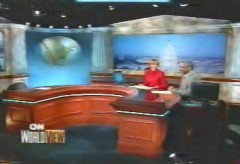 |
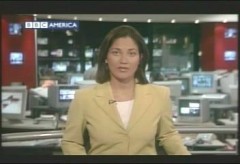 |
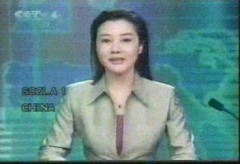 |
|
CNN WorldView
|
BBC World News
|
China
|
 |
 |
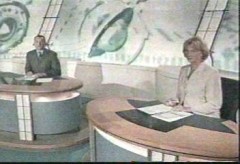 |
|
Croatia
|
Dubai
|
Germany
|
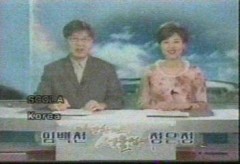 |
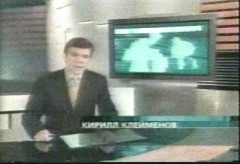 |
 |
|
Korea
|
Russia
|
Vietnam
|
The anchor is the person who provides continuity for the broadcast and across broadcasts. Female and male anchors seem roughly equal in numbers. News is no longer a male only province.
| World View Germany Korea Slovenia Russia Vietnam |
 |
One widely practiced transition into a story is the symbol over the shoulder of the anchor person. The symbol can be a word, a phrase or an image that is readily recognized. They are iconographic representations of the story being introduced. The first of the images in the video to the right is from WorldView and the image is from Hitler's Germany. Click on the image to see examples of the icons used in international broadcasting.
Another standard transition into a story is the split screen.
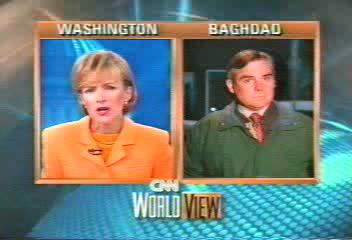 |
WorldView |
The anchor and the reporter talk for a few seconds and then the reporter is pictured full screen. In the first of these examples the conversation is between the anchor in Washington D.C. and the reporter in Baghdad. At that distance there is a couple of seconds between question and answer. In the other three examples the anchor and reporter are much closer to each other. There is little distance related delays.
Click on the image to the left to see the video.
| World News Vietnam Palestine WorldView |
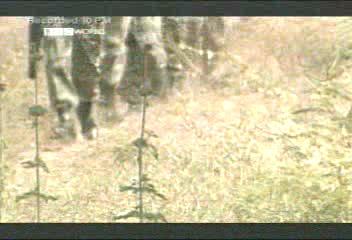 |
Pictures. It is not TV without pictures. There is much video in all of the broadcasts we examined. The examples chosen, that can be seen by clicking on the picture at the right, illuminate this point in several ways.
The first is a reporter talking over video footage of soldiers of the Tamil Tigers. The story was about a news conference held by the leader of the Tamil Tigers to say that they would be willing to negotiate if they could engage in the negotiations safely. This footage is not terribly relevant to the story. It is simply a way of illustrating the reporter saying that the Tamil Tigers had a substantial military. You have to have pictures. If you are going to talk about the military strength of the Tamil Tigers then you have to have pictures of some of their soldiers shooting, but they are shooting at nothing.
The second and third examples involve talking over the speaker. In both cases they are translating what the speaker is saying. The irony is that the speakers are both locals -- one Vietnamese and the other Palestinian -- but they are speaking in English. They appear to intend to speak to a wider audience, and that speaking has to be translated for the local audience. But you need pictures of them saying it -- even though what they say has to be translated.
The final example is another reporter talking over video of Indian soldiers. The story is about fighting. The fighting is over, and the pictures are of the military not fighting. But you need pictures of soldiers to talk about fighting.
 |
|
Click Image to Play Video [0:05]
|
In the U.S. media -- both newspapers and TV -- quite often there is a story of the day. It is the story that you can find on every front page and in every news broadcast. There was a story of the day the day we looked at the news broadcasts from around the world.
The day was April 5, 2002. The Israeli invasion of Palestine was nine days old. The story of the day on CNN's Headline News was a visit by U.S. ambassador Zinni with Yasser Arafat. They agreed on a negotiating team, but Israel's prime minister Sharon vetoed the idea.
Around the world the story of the day was dying Palestinians. Death and destruction was the centerpiece of the news from the Middle East.
 |
|
Click Image to Play Video [1:11]
|
There were tanks in the streets of Ramallah and Palestinian gunmen firing automatic weapons. There were helicopters attacking and destroying buildings. But the story of the day seemed to be the small arms fire as gunmen ran the length of a street. That one scene was repeated over and over in the news broadcasts we found.
CNN's Headline News seems to have missed the story of the day.
Animated introduction with music. The anchor sitting at a desk introducing and concluding stories. Standard sequences passing the story from the anchor to the reporter. Everywhere video. And the story of the day. These features are ubiquitous. TV news broadcasting is a genre; an internationally practiced genre.
CNN's WorldView and BBC's World News are part of that global genre. It is not the format of presentation that sets them apart from more locally oriented news broadcasting. But for understanding the global scope of TV news broadcasting the generic character of the practice means that you will recognize the news wherever you go.